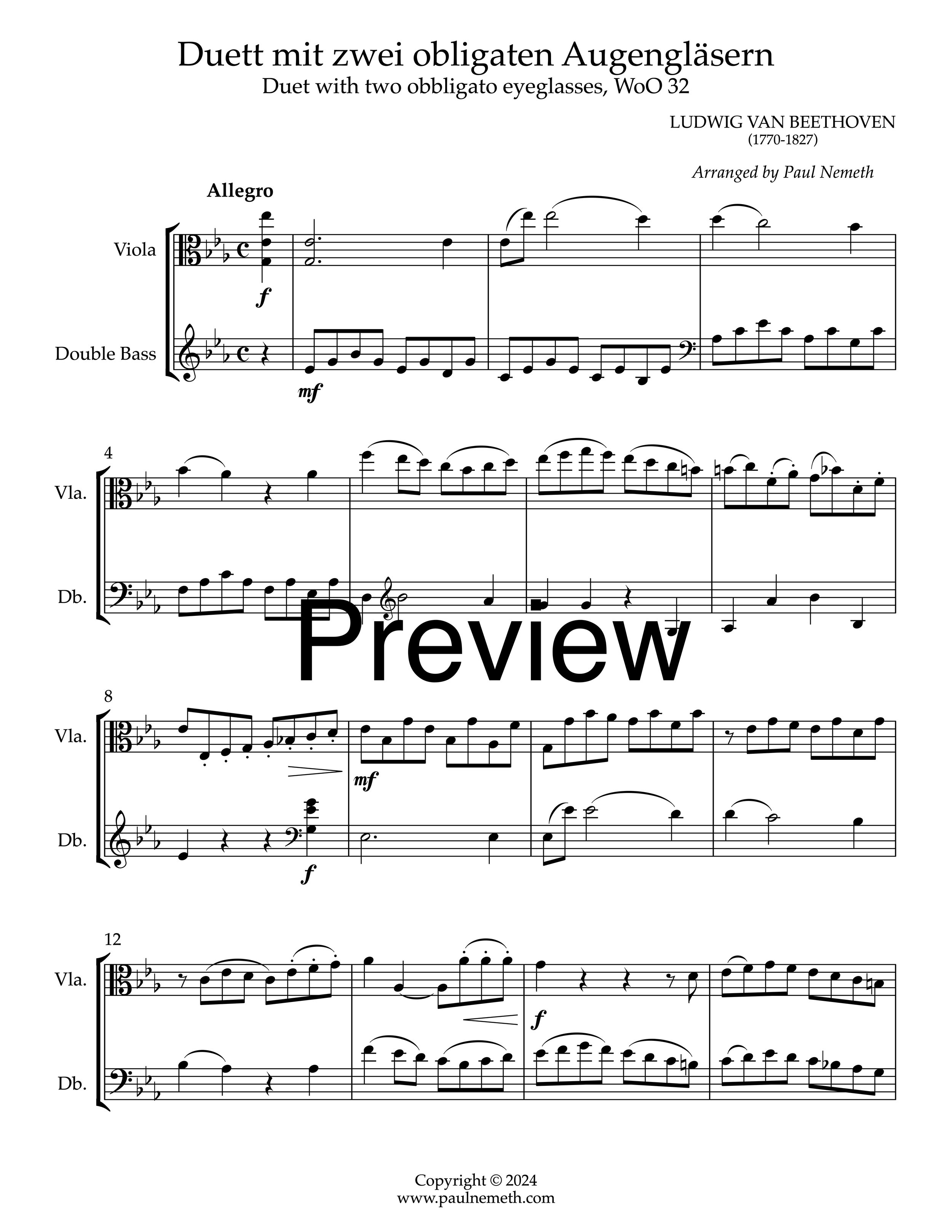Beethoven - Duet with Two Obbligato Eyeglasses, Transcribed for Viola and Double Bass - Score and Parts
Ludwig van Beethoven - Duett mit zwei obligaten Augengläsern (Duet with two obbligato eyeglasses), WoO 32, arranged for viola and double bass. Available as a PDF download with full score (15 pages) and parts (10 pages).
Now available is Beethoven’s “Duet with two obbligato eyeglasses”, arranged for viola and double bass. Beethoven wrote this piece for viola and cello when he was employed in one of his first gigs as a tutti violist in the court orchestra of Bonn as a teenager. The incomplete manuscript survives inside of a book of manuscripts called the Kafka Sketchbook, named after one of its previous owners. While the sketchbook does contain many incomplete sketches from Beethoven, the first movement to this piece survives in whole. It was most likely written for Beethoven to play with his friend Nikolaus Zmeskall, who was an amateur cellist. Both Beethoven and Zmeskall wore glasses at the time, which explains the title given by Beethoven.
Unlike many of the arrangements that I’ve done, this edition doesn’t really make sense to be presented in an “Urtext transcription”. The manuscript is incomplete when it comes to musical markings and even though there is also a fragment of a minuet scored for the same instruments, it makes the most sense to play this movement by itself with some editorializing. The bass part in this edition has been modified with octave changes and modifications of double stops that only work on the cello. The end result is more satisfying for the player than trying to reproduce an incomplete score and with the changes to the bass part, it brings out the lower range of the instrument.
Ludwig van Beethoven - Duett mit zwei obligaten Augengläsern (Duet with two obbligato eyeglasses), WoO 32, arranged for viola and double bass. Available as a PDF download with full score (15 pages) and parts (10 pages).
Now available is Beethoven’s “Duet with two obbligato eyeglasses”, arranged for viola and double bass. Beethoven wrote this piece for viola and cello when he was employed in one of his first gigs as a tutti violist in the court orchestra of Bonn as a teenager. The incomplete manuscript survives inside of a book of manuscripts called the Kafka Sketchbook, named after one of its previous owners. While the sketchbook does contain many incomplete sketches from Beethoven, the first movement to this piece survives in whole. It was most likely written for Beethoven to play with his friend Nikolaus Zmeskall, who was an amateur cellist. Both Beethoven and Zmeskall wore glasses at the time, which explains the title given by Beethoven.
Unlike many of the arrangements that I’ve done, this edition doesn’t really make sense to be presented in an “Urtext transcription”. The manuscript is incomplete when it comes to musical markings and even though there is also a fragment of a minuet scored for the same instruments, it makes the most sense to play this movement by itself with some editorializing. The bass part in this edition has been modified with octave changes and modifications of double stops that only work on the cello. The end result is more satisfying for the player than trying to reproduce an incomplete score and with the changes to the bass part, it brings out the lower range of the instrument.
Ludwig van Beethoven - Duett mit zwei obligaten Augengläsern (Duet with two obbligato eyeglasses), WoO 32, arranged for viola and double bass. Available as a PDF download with full score (15 pages) and parts (10 pages).
Now available is Beethoven’s “Duet with two obbligato eyeglasses”, arranged for viola and double bass. Beethoven wrote this piece for viola and cello when he was employed in one of his first gigs as a tutti violist in the court orchestra of Bonn as a teenager. The incomplete manuscript survives inside of a book of manuscripts called the Kafka Sketchbook, named after one of its previous owners. While the sketchbook does contain many incomplete sketches from Beethoven, the first movement to this piece survives in whole. It was most likely written for Beethoven to play with his friend Nikolaus Zmeskall, who was an amateur cellist. Both Beethoven and Zmeskall wore glasses at the time, which explains the title given by Beethoven.
Unlike many of the arrangements that I’ve done, this edition doesn’t really make sense to be presented in an “Urtext transcription”. The manuscript is incomplete when it comes to musical markings and even though there is also a fragment of a minuet scored for the same instruments, it makes the most sense to play this movement by itself with some editorializing. The bass part in this edition has been modified with octave changes and modifications of double stops that only work on the cello. The end result is more satisfying for the player than trying to reproduce an incomplete score and with the changes to the bass part, it brings out the lower range of the instrument.
